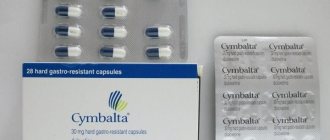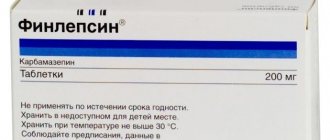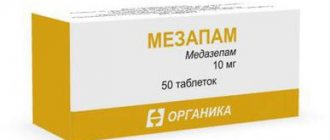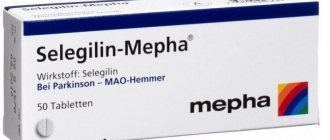In this article we will figure out how long Alprazolam works.
The drug is quickly absorbed into the blood and quickly relieves symptoms, so it is suitable as emergency aid in a stressful situation - within 15-20 minutes. The maximum concentration of the drug in the blood is achieved 1 to 2 hours after administration. Valid for 2-3 hours.
It is a drug classified as a tranquilizer. The drug is produced in tablet format. This medicine is included in the list of psychotropic medicines and is subject to quantitative accounting.
There are a lot of reviews about Alprazolam.
Composition of tablets
This product is produced only in one form - in the form of tablets. They are packaged in a jar. They are also packaged in blisters of ten or fifty pieces. Alprazolam belongs to the group of anti-anxiety tranquilizers. The medicine is extremely rarely prescribed for long-term treatment, as there is a danger of addiction.
The active component of these tablets is the substance of the same name, alprazolam. Auxiliary ingredients include potato starch along with magnesium stearate, lactose monohydrate and low molecular weight povidone.
Cost of medicines
Prices for medicine may vary depending on the region of the country, pharmacy, manufacturer and the number of tablets in the package. The comparison table presents the average price of Alprazolam and its analogues.
| Name of the medication | Dosage of the active component in 1 tablet/capsule (mg) | Average price in rubles |
| Alprazolam | 0.25 or 1 | 700 |
| Helex | 0,25; 0,5; 1 | 650 |
| Xanax | 0,25 | 700 |
| Zolomax | 0, 25 or 1 | 800 |
| Neurol | 0, 25 or 1 | 900 |
| Alprox | 0,25; 0,5; 1 | 700 |
| Nozepam | 10 | 94 |
| Relanium | 5 | 200 |
| Spitomin | 5 or 10 | 200 |
Mechanism of action
Alprazolam tablets are prescribed in short courses to quickly relieve nervous disorders. The antidepressant has muscle relaxant and anxiolytic activity, and, in addition, has anticonvulsant and hypnotic effects. This remedy is taken to relieve anxiety and unreasonable anxiety.
The drug "Alprazolam" allows you to increase the duration and quality of sleep, reducing the time of falling asleep and waking up. The presented tablets relieve brain excitability, dulling the body's reflexes. The anticonvulsant effect involves relieving muscle tension and eliminating spasms. This leads to relaxation of the whole body, and, in addition, to emotional calm.
pharmachologic effect
Alprazolam has antidepressant, hypnotic, tranquilizing, central muscle relaxant, and antiepileptic effects. Therefore, it is prescribed for the treatment of anxiety elimination and muscle relaxation.
The drug also has anticonvulsant activity and has a moderate hypnotic effect. Under the influence of the drug, the patient's time to fall asleep is shortened, and the duration of sleep, on the contrary, increases with the almost complete elimination of waking up at night.
Pharmacological properties of the drug
The drug acts as a high-potency benzodiazepine, enhancing the inhibitory effect of aminobutyric acid in the nervous system. The mechanism of the sleeping pill is as follows: when it enters the intestine, the active component is quickly absorbed into the body. The maximum concentration of this substance is observed two hours after administration. In the liver, the active component is metabolized, and the resulting metabolites are excreted from the body naturally in the urine.
General information about the drug
Alprazolam is a tranquilizer that is prescribed for various mental disorders, including depressive conditions.
Under the influence of the medication, feelings of fear and anxiety are eliminated, sleep improves, and symptoms of emotional overstrain also recede. Used for long-term treatment of panic attacks. For anxiety, anxiety or fear, take in short courses.
Drug group, INN, scope of application
The drug is part of the group of anxiolytic drugs. INN: Alprazolam. The mechanism of action of the drug (hereinafter referred to as the drug) is determined by the active component. This tranquilizer is a triazolobenzodiazepine derivative. It has a moderate hypnotic effect, which is combined with pronounced anxiolytic activity.
General information about the drug
Used for insomnia, depression, feelings of fear/anxiety. LP is also prescribed for social phobia. Helps eliminate withdrawal symptoms in people with alcohol or drug addiction.
Release forms and average prices for the drug in Russia
The drug goes on sale only in tablet form. At the pharmacy you can buy tablets in cardboard packaging with blisters (5 pieces of 10 tablets each) or a polymer jar, which also contains 50 pieces.
Since this product is a potent drug, it can only be purchased with a prescription. To date, there is no information on the availability and cost of Alprazolam. To clarify the price and availability in pharmacies, you can contact the managers of the nearest pharmacy points.
Compound
Alprazolam (0.25 and 1 mg) is used as the main active ingredient. The substance is a benzodiazepine derivative. The drug also includes a list of auxiliary components:
- magnesium stearate;
- potato starch;
- milk sugar;
- low molecular weight polyvinylpyrrolidone.
These substances ensure the binding of all components to each other and improve the tolerability of the drug. It is a white powder. Insoluble in water and ethanol. It has central, anxiolytic, sedative and muscle relaxant effects.
Pharmacodynamics and pharmacokinetics
The drug has a depressant effect on the central nervous system. The action takes place in the hypothalamus/thalamus and limbic system. Interacts with GABA receptors and benzodiazepine receptors. Leads to a decrease in the excitability of the thalamus, hypothalamus, limbic system, and inhibition of polysynaptic spinal reflexes.
The main effect of the drug is anxiolytic. The medication is characterized by a hypnotic and anticonvulsant effect. The active component reduces the level of nervous and emotional tension. Anticonvulsant properties include the elimination of muscle spasms. As a result, the feeling of anxiety is relieved and the patient experiences relaxation.
Mechanisms of action of antiepileptic drugs
By inhibiting the cells of the reticular formation of the brain, a hypnotic effect is achieved. The drug does not affect the respiratory and cardiovascular systems.
After the substance enters the body, the peak concentration level is observed after 1-2 hours. The concentration of the drug directly depends on the dose. About 80% of the substance binds to plasma proteins. The metabolic process takes place in the liver. The half-life is 12-15 hours. The active substance and its metabolites are excreted from the body through the kidneys.
Indications for use
Alprazolam tablets are prescribed by the attending physician when diagnosing the following pathologies:
- The presence of neuroses, anxiety, irritability, anxiety disorders, states of excitement and emotional stress in a person. At the same time, patients experience a deterioration in the quality of sleep along with nightmares, insomnia and frequent waking up in the middle of the night.
- For somatic diseases accompanied by increased sweating, and, in addition, rapid heartbeat, bulimia, impotence or anorexia.
- A person is in an anxious-depressive state, leading to a decrease in mood and loss of interest in everything that is happening around.
- The drug is often prescribed for isolation or, on the contrary, agitation, against the background of suicidal actions and endogenous depression. The indications for Alprazolam must be strictly followed.
- In the presence of neuroses, accompanied by loss of appetite, and at the same time weight changes.
- The presence of depression in a person due to illness, for example, due to oncology or fear of a heart attack.
- The drug is prescribed for the treatment of alcoholism or drug addiction.
- The presence of phobias of a different nature in a person, including fear of open space and the like.
- Presence of tremors and panic attacks.
Substitutes for their effect on the body
Among the effective remedies similar in action, developed on the basis of other active ingredients, are Nozepam, Relanium, Spitomin.
Nozepam
This drug based on oxazapm is a tranquilizer that has a sedative, hypnotic and anticonvulsant effect. Thanks to its anxiolytic effect, the drug effectively reduces emotional stress, eases fear and anxiety. The medication has little effect on symptoms of psychotic origin and rarely eliminates affective tension and delusional disorders. The main indications for use are:
- Neuroses and neurosis-like conditions.
- Irritability.
- Vegetative lability.
- Fatigue quickly.
- Problems with sleep.
Nozepam is administered orally, regardless of food intake. The initial dose, the use of which should be divided into 2-3 times, is 10 mg. Gradually the amount of medication taken is increased to 30 mg. Outpatient treatment allows taking from 30 to 50 mg, and inpatient treatment – up to 120 mg per day. The duration of therapy is determined by the doctor. The average duration of treatment is from 2 to 4 weeks.
Article on the topic: Which is better Neurox or Mexidol and the differences between the drugs
Treatment with Nozepam can cause a number of side effects:
- depression;
- irritability;
- suicidal tendencies;
- increased anxiety;
- outbursts of aggression;
- heartburn;
- tachycardia.
Nozepam is contraindicated in myasthenia gravis, coma, shock, obstructive pulmonary disease, treatment with analgesics, glaucoma and severe depression. The medicine is not taken by children and pregnant women. If it is necessary to use the drug during lactation, breastfeeding will have to be abandoned.
Relanium
This analogue of Alprazolam based on diazepam is available in the form of a solution for intramuscular and intravenous administration. It has a sedative and muscle relaxant effect and is prescribed for:
- Neurotic disorders with anxiety.
- Withdrawal syndrome in alcoholism.
- Epileptic seizures.
- Increased excitability.
- Convulsive states.
Relanium is injected slowly into a large vein at a rate of 5 mg per minute. From 10 to 20 mg of the drug can be administered to relieve psychomotor agitation, treat status epilepticus and skeletal muscle spasm. Due to the fact that the drug is used in pediatric practice, children are prescribed the following doses:
- 0.1-0.3 mg/kg up to the limit of 5 mg for newborns;
- 1 mg every 2-5 minutes up to a maximum of 10 mg for children over 5 years of age.
Taking Relanium is contraindicated for:
- Coma.
- Shocked.
- History of alcohol or drug addiction.
- The period of breastfeeding.
- Pregnancy.
- Alcohol intoxication.
- Respiratory failure.
- Infancy up to 30 days.
Spitomin
Spitomin based on buspirone is an antidepressant and anxiolytic drug. The medication has an antidepressant effect, but unlike the drugs described above, it does not have sedative, muscle relaxant and antiepileptic effects. Spitomin is indicated for:
- Panic and depressive disorders.
- Autonomic dysfunction syndrome.
Contraindications to the use of the drug:
- Intolerance to its components.
- Kidney failure.
- Glaucoma.
- Lactation period.
- Pregnancy.
- Age up to 18 years.
Spitomin is produced in tablet form. The initial daily dose of the drug taken is 15 mg and should be divided into 2-3 doses. Gradually the daily dose increases to 20-30 mg. The maximum dose to be taken per day is 60 mg.
Spitomin is well tolerated, and the following side effects occur at the beginning of treatment and soon disappear:
- chest pain;
- fainting;
- dizziness;
- apathy;
- noise in ears;
- nausea.
Mode of application
The number of tablets for treatment depends on the dosage, age, condition of the patient and the body’s sensitivity to the components of the drug. The tablets, according to the instructions, are taken orally three times a day, regardless of food. The capsule is not chewed, but swallowed whole, washed down with plenty of still water. In order to wash down the medicine, you will need at least half a glass of water.
The daily dosage of Alprazolam is not taken at one time, it is divided into three doses. By the way, it is recommended to take most of it before bed, as this will promote a hypnotic effect on the body. For example, the daily dose of tablets is 2 milligrams: in this case, the patient takes 0.5 milligrams in the morning and at lunch, and immediately before bed the dosage is 1 milligram.
The maximum daily dose of the drug should not exceed 10 milligrams. For elderly patients after sixty-five years of age, the maximum norm is 1.5 milligrams per day. Treatment should not be started without the prescribed dosage. Therapy should begin with a minimum dose of 0.25 milligrams per day and gradually increase. Thus, in three weeks it is brought to normal. Depending on the diagnosis, the patient is prescribed the following amount of the active ingredient:
- If you have anxiety, you should take 1.5 milligrams three times.
- As part of the treatment of depression, take 3 milligrams three times.
- If you have phobias or panic attacks, the dosage is 3 milligrams three times.
The course of taking Alprazolam can be long or, conversely, short:
- Long-term treatment with Alprazolam is rarely prescribed due to the many side effects that this drug can cause. Such treatment is prescribed for chronic depression and anxiety.
- A short course of therapy is carried out when it is necessary to stop an acute and at the same time sudden attack of fear, as well as when it is necessary to relieve a nervous state. A short treatment course usually lasts no more than seven days. In this case, the dosage is 0.5 milligrams three times a day.
Composition (what it is made from)
The active ingredient of the drug is alprazolam.
Release form: tablets packed in blisters of 10 pieces or in polymer jars of 50 pieces.
One tablet of Alprazolam 0.25 (1) contains 0.25 (1) mg of the active ingredient and additional ingredients (starch, silicon dioxide, lactose, magnesium stearate, etc.).
Analogues of the drug include: Alzolam, Zolomax, Alprox, Xanax, Kassadan, Neurol, Frontin and Helex.
One of the popular drugs that has a sedative and hypnotic effect is Alprazolam, which has an antidepressant effect, which ensures healthy sleep and relieves attacks of fear. Before taking the medicine, you should consult your doctor. Alprazolam has side effects, contraindications and other features that need to be taken into account during treatment.
The product is available in one form - tablets for oral administration, which are packaged in a jar, or blisters of 10 or 50 pieces. There are pills with different dosages, this should be taken into account when purchasing.
Alprazolam belongs to the group of anxiolytics or anti-anxiety tranquilizers. It is rarely prescribed for long-term treatment due to addiction.
Alprazolam is prescribed in short courses to quickly relieve nervous disorders.
The antidepressant has muscle relaxant and anxiolytic activity, anticonvulsant and hypnotic effects. Alprazolam is taken to relieve feelings of anxiety and unreasonable anxiety.
The anticonvulsant effect is to relieve muscle tension and eliminate spasms. This leads to relaxation of the body and emotional calm.
The drug contains auxiliary components:
- potato starch;
- magnesium stearate monohydrate;
- lactose monohydrate;
- low molecular weight povidone.
The drug is a high-potency benzodiazepine, which enhances the inhibitory effect of gamma-aminobutyric acid in the central nervous system and increases the sensitivity of GABA receptors to this mediator.
The mechanism of the sleeping pill is as follows: when it enters the intestine, the active substance is quickly absorbed into the body. The maximum concentration of alprazolam is achieved 1-2 hours after taking the tablets.
The active substance is metabolized in the liver, and the resulting metabolites are excreted from the body naturally in the urine.
Tablets are prescribed by the attending physician when diagnosing the following problems:
- Neuroses, anxiety, irritability, anxiety disorders, excitement, emotional stress. At the same time, there is a deterioration in the quality of sleep, nightmares, insomnia, and frequent waking up in the middle of the night.
- Somatic diseases accompanied by excessive sweating, rapid heartbeat, impotence, bulimia, anorexia.
- Anxious-depressive state, leading to decreased mood, loss of interest in what is happening around, isolation or, conversely, agitation, suicidal actions, endogenous depression.
- Neuroses accompanied by loss of appetite, changes in body weight.
- Depression occurring against the background of a disease, for example, the cardiovascular system, oncology, from fear of a heart attack, as a reaction to treatment for alcoholism or drug addiction.
- Phobias of various types, including fear of open space (agoraphobia).
- Tremor.
- Panic attacks.
The number of Alprazolam tablets depends on many factors:
- dosage;
- age, condition of the patient;
- sensitivity to the component.
According to the instructions, tablets are taken orally 2-3 times a day, regardless of meals. The capsule is not chewed, but swallowed whole and washed down with a large amount of clean still water (at least 0.5 cups).
The daily dose is not taken at one time, it is divided into two or three doses, while most of Alprazolam must be taken before bed due to the hypnotic effect of the drug on the body.
For example, the daily dose of the drug is 2 mg: in this case, the patient takes 0.5 mg in the morning and at lunch, and before bed the dose is 1 mg.
Therapy should begin with a minimum dose of 0.25 mg per day and gradually increase, in two to three weeks it is brought to normal.
Depending on the diagnosis, the patient is prescribed the following amount of active substance:
- for anxiety – 0.25-1.5 mg three times a day;
- treatment of depression – 0.5-3 mg three times a day;
- for phobias or panic attacks, the dosage indicated in the instructions is 1-3 mg three times a day.
https://www.youtube.com/watch?v=Tk2kMmHU_vc
The course of treatment can be long or short:
- Long-term treatment with Alprazolam tablets is rarely prescribed due to the mass of side effects that the drug can cause. It is prescribed for chronic depression and anxiety.
- A short course of treatment is carried out when it is necessary to suppress an acute, sudden attack of fear or relieve a nervous state. It lasts 3-7 days. In this case, the dosage is 0.25-0.5 mg three times a day.
A feature of Alprazolam tablets is the cessation of treatment after a long course of use. This must be done gradually, otherwise the patient cannot avoid the return of increased symptoms of the condition for the treatment of which Alprazolam was prescribed.
The duration of Alprazolam withdrawal is from two to four weeks (depending on the dosage). To do this, you need to remove 0.25-0.5 mg of the drug from the daily dose every three days.
If reducing the dose by 0.5 mg returns signs of anxiety, a more gradual withdrawal should be carried out.
special instructions
When prescribing this medicine, the doctor must make sure that the patient has not taken other tranquilizers and psychotropic substances, and was not an alcoholic: the patient’s sensitivity to the drug depends on this.
The effectiveness of treatment with Alprazolam tablets will be lower in people who suffered from alcoholism or drug addiction or took different types of antidepressants.
Alprazolam is not recommended to be taken with other sedative medications that cause drowsiness.
A long course of treatment with tablets can cause a patient with depression to become dependent on Alprazolam - benzodiazepine addiction, which is difficult to get rid of. Therefore, it is forbidden to increase or decrease the dosage on your own without consulting a doctor.
If the dosage is reduced quickly, you can observe the development of pill withdrawal syndrome, expressed in vomiting, nausea, sweating, insomnia, and anxiety.
If during treatment the patient begins to complain of hallucinations, convulsions, aggressiveness, or thoughts of suicide, it is necessary to consult a doctor.
READ MORE: Vinpocetine tablets and injections: instructions for use, price, reviews and analogues of the drug
During pregnancy
The tranquilizer Alprazolam should not be taken during pregnancy and lactation. The active substance contained in this drug may cause disturbances in the development and growth of the fetus due to intoxication in the first trimester.
In the second trimester of pregnancy, Alprazolam tablets, when used for a long time for more than a month, provoke withdrawal syndrome in a newborn child.
In the last weeks of gestation, taking the drug in rare cases causes a disruption in the development of the central nervous system of the newborn's central nervous system.
The active ingredient of the drug also passes into milk, so its use is prohibited during breastfeeding.
If taking Alprazolam tablets is necessary, the mother should transfer the child to artificial formula feeding.
Alprazolam tablets, when taken simultaneously with other medications, cause the following factors:
- CNS depression with simultaneous treatment with other psychotropic, anticonvulsant, analgesic drugs, hypnotics and histamine blockers.
- The possibility of overdose with Alprazolam tablets and an increase in its effectiveness when taking oral contraceptives and cardiac glycosides, ketoconazole, itraconazole, paroxetine, fluvoxamine.
- Increased concentrations of Imipramine, antihypertensive drugs.
- Increased toxicity of Zidovudine.
- Respiratory depression when taken with Clozapine.
Alprazolam and alcohol should not be taken together, otherwise it can lead to a toxic effect and other unpleasant and irreversible consequences:
- lowering blood pressure;
- blood clotting disorders;
- poor blood circulation in the brain;
- stroke, heart attack.
Side effects
Alprazolam tablets sometimes have side effects:
- feeling tired, drowsiness, slow reaction, depression, dizziness, disorientation, tremor, insomnia;
- dry mouth, nausea, constipation, diarrhea, impaired liver and kidney function, jaundice;
- anemia, chills, fever, sore throat, thrombocytopenia, neuropenia;
- enuresis, urinary retention, changes in libido, dysmenorrhea;
- decreased blood pressure, tachycardia;
- allergic reaction;
- change in body weight;
- visual impairment.
The use of psychotropic drugs must be strictly according to the instructions. When increasing the dose of the drug from 500 mg per day, an overdose is observed, which is easily recognized by the following signs:
- clouding of consciousness;
- decreased reflexes;
- drowsiness;
- dyspnea;
- bradycardia;
- tremor;
- decrease in blood pressure;
- coma.
Contraindications
The medicine Alprazolam has contraindications. Tablets that relieve anxiety symptoms are prohibited for the following diseases or conditions:
- coma;
- myasthenia gravis;
- angle-closure glaucoma;
- severe depression;
- poisoning with alcoholic beverages or drugs;
- respiratory tract diseases;
- age under 18;
- pregnancy and lactation;
- allergic reaction to the drug.
Alprazolam is available by prescription. The shelf life of the drug is 5 years from the date of release. Store out of the reach of children at a temperature not exceeding 30 degrees Celsius.
Alprazolam analogue
Alprazolam or Phenazepam tablets can be replaced with another option with a hypnotic effect and the same composition. Among Alprazolam analogues, Xanax and other tablets are popular:
- Alzolam;
- Zolomax;
- Neurol;
- Helex.
Alprazolam price
Stopping the medication
A feature of these tablets is the cessation of therapy during long courses of use. This must be done gradually, otherwise the patient cannot avoid the next occurrence of the same symptoms for which the drug was prescribed.
The duration of treatment is usually from two to four weeks, which directly depends on the dosage. To do this, you need to reduce the dose by 0.5 milligrams every three days. If reducing the dosage by 0.5 milligrams returns the previous signs of anxiety, a gentler withdrawal is required.
What to do, how to alleviate and get rid of
During the period of reducing the tranquilizer dosage, it is recommended:
- Consult your pharmacist. His professional knowledge is quite important to successfully achieve the goal of reducing the dosage of the drug. He will recommend which medications (over-the-counter) you should not take and which you can. If the doctor replaces the tranquilizer Alprazolam with other medications, this must be taken into account in the plan for gradually reducing the dose.
- Maintain good health. This will significantly strengthen the body’s strength and allow it to more easily endure the process of self-purification. Regular exercise and a healthy lifestyle will help minimize the number and intensity of symptoms. It is recommended to drink plenty of fluids, eat only healthy foods, fresh fruits and vegetables, and get good sleep.
- Do not drink alcohol, caffeine, or smoke. Alcohol, for example, promotes the formation of dangerous toxins, which will interfere with the rapid recovery process.
- Do not take over-the-counter medications without first consulting your doctor or pharmacist. Many of these medications increase stress on the nervous system. The most common of them are sleeping pills and antihistamines.
- Keep a diary constantly. It is recommended to carefully monitor the reduction in Alprazolam dosage using records that should indicate important information (when the drug is taken, dosage), as well as any signs of withdrawal or changes in mood.
- See your doctor regularly. The frequency of visits directly depends on the individual dosage reduction schedule. The doctor should be informed about any withdrawal symptoms, experiences and existing difficulties. If withdrawal symptoms manifest themselves in the form of hallucinations or seizures, you should seek medical help immediately.
- Consult your doctor about taking other medications. If there are serious, difficult-to-tolerate signs of withdrawal, the doctor may prescribe other medications that can eliminate or mitigate them. These drugs include anticonvulsants (for example, Tegretol). During the period of withdrawal from Alprazolam, the likelihood of dangerous epileptic seizures increases significantly.
- Go to an appointment with a psychologist or psychotherapist. In order to reverse the neurological changes caused by taking Alprazolam, treatment will be required that will last more than one month. Consultations with a doctor will help you overcome the difficulties that have arisen and regain your mental health.
Reducing the dose of the drug should occur within such acceptable limits that it is convenient for the patient. Gradually reducing the dose of the drug minimizes the occurrence of withdrawal symptoms.
The goal is to stop taking the medication without experiencing long-term side effects, rather than to complete a withdrawal plan as quickly as possible and experience depressing side effects. The longer you take Alprazolam, the longer it will take for your brain to return to normal after you stop taking it.
special instructions
As part of prescribing this medicine, the doctor must make sure that the patient has not taken any other tranquilizers and is not an alcoholic. The effectiveness of therapy with Alprazolam tablets will be significantly lower in people suffering from alcoholism or drug addiction and taking various types of antidepressants.
They should not be taken in combination with other sedative medications that cause drowsiness. A long course of pill therapy can cause a patient with depression to become highly dependent on Alprazolam, which will be difficult to get rid of. In this regard, it is forbidden to increase or decrease the dose without consulting a doctor.
If the dose is reduced quickly, you may experience pill withdrawal syndrome, which will be expressed in the form of vomiting, nausea, sweating, insomnia, anxiety, and the like. When, during treatment, the patient begins to complain of hallucinations, and, in addition, of seizures, aggressiveness and thoughts of suicide, it is necessary to consult a doctor.
Synonyms (analogues)
Alzolam, Zoldak, Kassadan, Xanax, Xanax retard, Lamoz, Neurol, Frontin, Helex
Alprazolam is a tranquilizer that is prescribed to relieve emotional stress, reduce feelings of anxiety and fear. Due to serious contraindications and a number of side effects, the medication is dispensed strictly according to prescription.
The content of the article
The drug "Alprazolam" belongs to the group of anxiolytic drugs. It has a sedative, hypnotic, central muscle relaxant and anticonvulsant effect. Prescribed to patients who suffer from anxiety, neuroses, and depression.
The drug is available in tablet form. The active ingredient is alprazolam. The dosage of alprazolam in each tablet is 1 mg.
In pharmacies, with a prescription, you can buy not only Alprazolam, but also its analogues. The following drugs have a similar effect:
- "Alzolam";
- "Xanax";
- "Frontin";
- "Helex";
- "Nozepam";
- "Sibazon";
- "Elenium".
Prices for Alprazolam and its analogues vary depending on the trade name, country of origin, and the number of tablets in one package. The average cost of a pack of the drug is 350–600 rubles (10 tablets with a dosage of 1 mg).
The drug "Alprazolam" is prescribed to patients suffering from the following diseases:
- anxiety states;
- neuroses and irritability;
- loss of sleep;
- neurotic depression arising from somatic diseases;
- panic states.
The dosage and duration of treatment are selected for each patient individually. The initial dose is 250–500 mcg three times a day. The maximum daily dose is 4.5 mg/day. The dose should be reduced or discontinued gradually - every three days, reduce the daily dosage by 500 mcg. Some patients require a slower dosage reduction.
While taking Alprazolam, patients may experience side effects. Most often, patients complain of the following symptoms:
- drowsiness, dizziness, absent-mindedness, disorientation, depressive states;
- dry mouth or increased salivation, nausea, vomiting, problems with bowel movements, decreased appetite;
- neutropenia, agranulocytosis, anemia, leukopenia;
- urinary incontinence or retention, changes in libido, dysmenorrhea;
- change in body weight;
- tachycardia, hypotension;
- skin rash, redness, itching.
Side effects should be reported to your doctor. Only a specialist has the right to adjust the dosage, replace the drug with an analogue, or suspend treatment.
Alprazolam has serious contraindications for use. The list includes:
- states of shock;
- coma;
- myasthenia gravis;
- poisoning with alcohol, sleeping pills and/or psychotropic drugs;
- severe depressive states;
- acute respiratory failure;
- pregnancy and lactation.
The drug is not prescribed to patients of childhood and adolescence. If you are hypersensitive to benzodiazepines, the active substance, do not take the medicine.
Sources:
- Alprazolam: instructions for use
Russian name
Alprazolam
Alprazolamum (genus Alprazolami)
Gross formula
C17H13ClN4
Anxiolytics (antipsychotics)
F06 Other mental disorders caused by brain damage and dysfunction or physical illness F06.4 Organic anxiety disorder F10.2 Alcohol dependence syndrome F10.
3 Withdrawal state F11 Mental and behavioral disorders caused by the use of opioids F25 Schizoaffective disorders F29 Non-organic psychosis, unspecified F32 Depressive episode F34.0 Cyclothymia F34.1 Dysthymia F40.0 Agoraphobia F40.1 Social phobias F41.
0 Panic disorder [episodic paroxysmal anxiety] F41.1 Generalized anxiety disorder F42 Obsessive-compulsive disorder F43.0 Acute stress reaction F43.1 Post-traumatic stress disorder F43.
2 Adjustment disorder F44 Dissociative [conversion] disorders F45 Somatoform disorders F79 Mental retardation, unspecified
G93.4 Encephalopathy, unspecified
CAS code
28981-97-7
Anxiolytic, benzodiazepine derivative. White or off-white fine-crystalline powder. Insoluble in water and poorly soluble in alcohol.
Pharmacology
Pharmacological action - anxiolytic, sedative, muscle relaxant, central.
After oral administration, it is quickly absorbed from the gastrointestinal tract. Cmax is reached within 1–2 hours. Plasma protein binding is 80%. Passes through the BBB and placental barrier, penetrates into breast milk. Metabolized in the liver. T1/2 - 16 hours. Excreted mainly by the kidneys. Repeated administration at intervals of less than 8–12 hours may lead to accumulation.
Neuroses and psychopathy, accompanied by fear, anxiety, restlessness; reactive depressive states (including against the background of somatic diseases), panic disorder, withdrawal syndrome in patients with alcoholism and drug addiction.
Contraindications
Hypersensitivity, severe respiratory failure, glaucoma (acute attack), acute liver and kidney diseases, myasthenia gravis, pregnancy (especially the first trimester), breastfeeding, age under 18 years.
Open-angle glaucoma, sleep apnea, chronic renal and/or liver failure, alcoholic liver damage.
FDA category of effect on the fetus is D.
Drowsiness, fatigue, dizziness, unsteadiness of gait, slowed mental and motor reactions, decreased concentration, nausea, constipation, dysmenorrhea, decreased libido, itching, paradoxical reactions (aggression, agitation, irritability, anxiety, hallucinations), addiction, drug dependence, withdrawal syndrome.
Interaction
Strengthens the effect of alcohol, neuroleptics and hypnotics, narcotic analgesics, central muscle relaxants. Increases serum concentrations of imipramine.
Overdose
Symptoms: CNS depression of varying severity (from drowsiness to coma) - drowsiness, confusion; in more severe cases (especially when taking other drugs that depress the central nervous system, or alcohol) - ataxia, decreased reflexes, hypotension, coma.
Treatment: induction of vomiting, gastric lavage, symptomatic therapy, monitoring of vital functions. For severe hypotension, norepinephrine is administered. The specific antidote is the benzodiazepine receptor antagonist flumazenil (administration only in a hospital setting).
READ MORE: Itraconazole instructions for use
Inside. The dosage regimen is set individually, depending on the course of the disease, tolerability, etc. Treatment should begin with the lowest effective dose. Typically, the initial dose for adults is 0.25–0.5 mg 3 times a day; if well tolerated (if necessary), the dose can be increased every 3–4 days. The maximum daily dose is 3–4 mg.
Please note that anxiety or tension associated with everyday stress does not usually require treatment with anxiolytics.
If paradoxical reactions occur, you must stop taking the drug. During the treatment period, drinking alcoholic beverages is prohibited. Use with caution while working for vehicle drivers and people whose profession involves increased concentration.
Alzolam, Alprazolam, Alpralide, Zoldak, Zolomax, Xanax, Cassadan, Lamoz, Neurol, Frontin, Helex
Alprazolam* (Alprazolam*) Anxiolytics 02.008 (Tranquilizer (anxiolytic))
Anxiolytic drug (tranquilizer), a derivative of triazolo-benzodiazepine.
It has an anxiolytic, sedative, hypnotic, anticonvulsant, and central muscle relaxant effect.
The mechanism of action is to enhance the inhibitory effect of endogenous GABA in the central nervous system by increasing the sensitivity of GABA receptors to the mediator as a result of stimulation of benzodiazepine receptors located in the allosteric center of postsynaptic GABA receptors of the ascending activating reticular formation of the brain stem and interneurons of the lateral horns of the spinal cord;
Pronounced anxiolytic activity (reduction of emotional stress, easing of anxiety, fear, restlessness) is combined with a moderately pronounced hypnotic effect; shortens the period of falling asleep, increases the duration of sleep, reduces the number of night awakenings. The mechanism of the hypnotic effect is the inhibition of the cells of the reticular formation of the brain stem. Reduces the impact of emotional, vegetative and motor stimuli that disrupt the mechanism of falling asleep.
Pharmacokinetics
After oral administration, alprazolam is quickly and completely absorbed from the gastrointestinal tract. Cmax in blood plasma is achieved within 1-2 hours.
Plasma protein binding is 80%.
Metabolized in the liver.
T1/2 averages 12-15 hours. Alprazolam and its metabolites are excreted mainly by the kidneys.
Dosage
Individual. It is recommended to use the minimum effective dose. The dose is adjusted during treatment depending on the effect achieved and tolerability. If it is necessary to increase the dose, it should be increased gradually, first in the evening and then in the daytime.
The initial dose is 250-500 mcg 3 times / day, if necessary, a gradual increase to 4.5 mg / day is possible.
Discontinuation or dose reduction of alprazolam should be carried out gradually, reducing the daily dose by no more than 500 mcg every 3 days; sometimes even slower withdrawal may be necessary.
Alprazolam during pregnancy
This tranquilizer should not be taken during pregnancy. The active substance contained in this drug can cause disturbances in the development and growth of the fetus at the beginning of pregnancy. In the last weeks of pregnancy, taking the drug is rare, but it disrupts the development of the nervous system of the unborn child.
If a woman took tablets of this drug immediately before giving birth, this can lead to a decrease in blood pressure and temperature, and, in addition, to breathing problems and weak sucking reflexes in the newborn.
The active component of the drug can penetrate into milk, so taking Alprazolam is prohibited during breastfeeding. If a young mother still needs to take these pills, she should transfer her child to artificial feeding.
Instructions for use
The standard instructions for Alprazolam indicate that the tablets are taken two to three times a day orally. The use of drugs is not tied to meals. The dosage should be individualized based on the patient's condition and age:
- If anxiety states occur, it is recommended to take the medicine three times a day, 0.25-0.5 mg. If necessary, the dose can be increased to 4 mg per day.
- For depression, 0.5 mg/3 times every 24 hours is prescribed. Gradually, the amount of the drug can be increased to 4.5 mg. It is recommended to take the initial dose before bedtime. This will help avoid increased sleepiness during the day.
- Patients of retirement age are prescribed 0.25 mg 2 times a day. If the human body tolerates the medication well, you can increase the amount to 0.5 mg.
Upon completion of the course of treatment, the dosage is gradually reduced. Abrupt cessation can lead to a number of unpleasant consequences. The course of treatment can last from 4 to 12 weeks.
It is dangerous to adjust dosages on your own. An incorrectly selected amount of medication can cause negative reactions or an overdose. To protect your body from undesirable consequences, you should adhere to the treatment regimen established by a specialist.
When taking Alprazolam simultaneously with various medications, their effectiveness may decrease and the risk of complications may increase.
| Medicines | Consequences |
| Fluvoxamine | Leads to an increase in the concentration of the main component of Alprazolam in plasma |
| Anticonvulsant and psychotropic drugs, ethanol, histamine H1 receptor blockers | Increased depressant effect on the nervous system |
| Digoxin | May cause intoxication with cardiac glycosides |
Alprazolam drug interactions
Taking pills while being treated simultaneously with other medications entails the following consequences:
- In the case of simultaneous treatment with other psychotropic, and at the same time anticonvulsant and analgesic drugs in the form of narcotics or sleeping pills, depression of the nervous system is possible.
- An overdose of Alprazolam tablets is possible, along with an increase in its effectiveness in the case of taking oral contraceptives, Ketoconazole, Paroxetine and Fluvoxamine.
- Alprazolam increases the toxicity of Zidovudine.
- Alprazolam depresses breathing when taken simultaneously with Clozapine.
Reviews about taking Alprazolam
To form a definite impression about the drug, its safety and effectiveness, you should read reviews of Alprazolam.
Doctors
Experts speak positively about this drug. With proper treatment, it effectively eliminates unpleasant symptoms and helps you return to your normal lifestyle:
Krasilnikov V.R., psychotherapist: “Alprazolam is an effective remedy in the treatment of depressive and neurotic conditions. However, at the same time, this is an extremely dangerous drug - even a slight overdose can cause serious consequences, so I do not recommend it for home treatment, although I often use it in a hospital.”
Side effects
According to reviews of Alprazolam, tablets can sometimes give the following side effects:
- Feeling tired, drowsy, slow to react, depressed, dizzy, confused, tremors, or insomnia.
- The presence of dry mouth, nausea, constipation, diarrhea, impaired liver and kidney function. The appearance of jaundice is possible.
- The presence of anemia, chills, fever, sore throat, thrombocytopenia and neutropenia.
- Development of enuresis, urinary retention. Decreased libido and dysmenorrhea are also possible.
- Reduced blood pressure and tachycardia.
- Development of allergic reactions.
- Weight changes along with visual impairment. The side effects of Alprazolam are described in detail in the instructions.
Contraindications
Dosage
According to the instructions, Alprazolam is not prescribed to patients with the following diseases:
- Myasthenia;
- Respiratory failure;
- Severe dysfunction of the liver and kidneys;
- Acute attacks of glaucoma.
The drug is contraindicated in persons with a history of hypersensitivity to the components of the drug or lactose intolerance.
Alprazolam is not used for acute poisoning with alcohol, narcotics, sleeping pills or psychotropic drugs.
This drug is not used in pediatric practice.
During treatment with Alprazolam, the use of drugs and drinks containing ethyl alcohol is prohibited; in addition, activities that require increased concentration should be limited.
Drug overdose
Treatment with psychotropic drugs should be carried out strictly according to the instructions. If the dose of the drug is increased from 500 milligrams per day, patients experience an overdose. Signs of an overdose of Alprazolam can be easily recognized by the following symptoms:
- The occurrence of clouding of consciousness along with decreased reflexes.
- The appearance of drowsiness, shortness of breath and bradycardia in a person.
- Development of tremor and decrease in blood pressure.
So, if you take Alprazolam as a sleeping pill, you need to be careful.
Overdose
An overdose of Alprazolam manifests itself in drowsiness, confusion, loss of coordination, decreased reflexes, and coma. In some cases, deliberate overdose of this drug can be fatal. Fatal overdose has been reported in patients who took the drug in combination with benzodiazepines, alcohol (blood alcohol levels were significantly lower than the degree of alcoholism leading to death).
Contraindications for use
The medicine has a large number of various contraindications. These tablets are prohibited for the following diseases and conditions:
- Against the background of a coma.
- For myasthenia gravis and angle-closure glaucoma.
- If you have severe depression.
- Against the background of alcohol poisoning.
- Presence of respiratory tract diseases.
- Patients are under eighteen years of age.
- The presence of an allergic reaction to the drug.
Adverse reactions and cases of overdose
During the course of treatment, side effects may occur. In most cases, they occur at the initial stage of treatment and then disappear while taking the drug or when adjusting the dose taken.
Pronounced side effects include feelings of fatigue, drowsiness,. Dizziness is also possible. In addition, during use, side effects may occur during the operation of such systems:
- Digestive systems
. In most cases, dry mouth, vomiting, nausea, heartburn, constipation or, conversely, diarrhea may occur. - Genitourinary system
. Violation of the normal functioning of the kidneys, a decrease or, conversely, an increase in libido, urinary incontinence or retention.
Allergic reactions may occur in the form of itching or rash on the skin. Diplopia and weight loss may also occur.
If you take too large doses of the drug, the amount of which is 500-600 mg per 24 hours or more, an overdose is possible. In case of an overdose, the following symptoms appear:
- drowsiness;
- dyspnea;
- tremor;
- decreased level of reflexes;
- the occurrence of bradycardia, low blood pressure or coma.
In case of overdose, the patient undergoes gastric lavage. Then sorbents are prescribed. Sorbents include Enterosgel, activated carbon, Polysorb.
Interaction with alcohol
Combining Alprazolam and alcohol is strictly prohibited, as this drug enhances the effect of alcoholic beverages on the body. If a person drinks alcohol while being treated with this drug, this can lead to sudden changes in blood pressure. In some cases, a stroke was observed.
Some people have reported chills while using this drug with alcohol. In addition, this combination can lead to vomiting or dizziness. When taking alcohol at the same time with this drug, people have impaired blood clotting, which leads to hemorrhages and bleeding. Improper treatment can lead to depression of the nervous system.
Reviews of Alprazolam are presented below.
Reviews from doctors and patients about what to take
Doctors and patients who have taken the drug leave different reviews about Alprazolam and its analogues. It is worth familiarizing yourself with them in order to understand how effective the drug really is and what side effects you should expect:
- Irina: “Alprazolam is an effective medicine that helped me cope with panic attacks that appeared due to VSD. The neurologist prescribed this remedy, and due to my illness I have to take it every six months. The drug helps me cope with anxiety, stabilizes my emotional background and improves sleep. Side effects include headache and dry mouth after the first dose of the medication, but these conditions soon passed. Despite the duration of treatment, Alprazolam did not cause dependence. Before that I took Realinium - the effect is not at all the same, but the price is good.”
- Oleg, neurologist: “Both Alprazolam and its structural analogues Helex, Xanax, Zolomax cope quite effectively with anxiety and panic attacks. The effect appears soon after the start of treatment. The drugs calm and normalize sleep. However, they do not cure, but only suppress symptoms. The products can also be addictive. To avoid developing dependence, do not take the medicine without consulting your doctor. With controlled administration, the occurrence of side effects will be minimized and the treatment will be safe. In case of intolerance."
Alprazolam is a well-established medicine. But the effect of the medication in question on the body may differ depending on the clinical picture of each patient. Its long-term and uncontrolled use can lead to overdose and addiction. Therefore, taking such a serious medicine as Alprazolam is possible and effective only under the supervision of a doctor.
Reviews
There are different reviews about this drug. Specialists involved in psychiatric and drug treatment practice use this drug quite widely. Other doctors prescribe these pills less frequently.
Judging by the reviews, patients do not particularly like this drug and explain this attitude by the many undesirable reactions that occur while taking it. In addition, complaints related to withdrawal syndrome are very common.
It is noted that even when dosages are observed, certain adverse reactions are often observed. There are comments that say that at first the drug helps cope well with a difficult mental state, but after completion of treatment it is very difficult to wean the body off it.
Symptoms and signs
Long-term use of Alprazolam or other benzodiazepines can cause persistent addiction and need, and abrupt cessation can lead to severe withdrawal symptoms.
After stopping the use of the drug, a variety of combinations of symptoms may appear, the severity of which is not always the same.
The most common signs include the following:
- frequent restlessness;
- irritability;
- causeless anxiety;
- headache;
- pale skin;
- panic attacks;
- severe sleep disorders;
- dizziness;
- severe fatigue;
- drowsiness;
- depression;
- increased sweating;
- loss of clarity of vision;
- tachycardia;
- mental disorder;
- everyday nausea;
- painful muscle pain.
Reducing the dosage under the guidance of a physician will minimize the likelihood of withdrawal symptoms.
Take the Attention Test! Find 10 differences! (click right here!)
Synonyms of nosological groups
Category ICD-10 Synonyms of diseases according to ICD-10
| F41.0 Panic disorder [episodic paroxysmal anxiety] | Panic |
| Panic attack | |
| Panic disorders | |
| Panic disorder | |
| Panic state | |
| F10.3 Withdrawal state | Alcohol withdrawal syndrome |
| Withdrawal syndrome | |
| Withdrawal syndrome in alcoholism | |
| Abstinence | |
| Alcohol withdrawal | |
| Alcohol withdrawal | |
| Alcohol withdrawal state | |
| Alcohol withdrawal syndrome | |
| Post-withdrawal disorder | |
| Post-withdrawal state | |
| Hangover syndrome | |
| Withdrawal syndrome | |
| Alcohol withdrawal syndrome | |
| Alcohol withdrawal syndrome | |
| Withdrawal state | |
| F32 Depressive episode | Adynamic subdepression |
| Astheno-adynamic subdepressive states | |
| Astheno-depressive disorder | |
| Astheno-depressive state | |
| Asthenodepressive disorder | |
| Asthenodepressive state | |
| Major depressive disorder | |
| Sluggish depression with lethargy | |
| Double depression | |
| Depressive pseudodementia | |
| Depressive illness | |
| Depressive mood disorder | |
| Depressive disorder | |
| Depressive mood disorder | |
| Depressive state | |
| Depressive disorders | |
| Depressive syndrome | |
| Depressive syndrome larvated | |
| Depressive syndrome in psychosis | |
| Masked depressions | |
| Depression | |
| Depression of exhaustion | |
| Depression with symptoms of lethargy within the framework of cyclothymia | |
| Depression smiling | |
| Involutional depression | |
| Involutionary melancholy | |
| Involutional depressions | |
| Manic-depressive disorder | |
| Masked depression | |
| Melancholic attack | |
| Neurotic depression | |
| Neurotic depression | |
| Shallow depressions | |
| Organic depression | |
| Organic depressive syndrome | |
| Simple depression | |
| Simple melancholic syndrome | |
| Psychogenic depression | |
| Reactive depression | |
| Reactive depression with moderate psychopathological symptoms | |
| Reactive depressive states | |
| Reactive depression | |
| Recurrent depression | |
| Seasonal depressive syndrome | |
| Senestopathic depression | |
| Senile depression | |
| Senile depression | |
| Symptomatic depression | |
| Somatogenic depression | |
| Cyclothymic depression | |
| Exogenous depression | |
| Endogenous depression | |
| Endogenous depressive states | |
| Endogenous depression | |
| Endogenous depressive syndrome | |
| F41.2 Mixed anxiety and depressive disorder | Depression with anxiety-depressive components |
| Mixed anxiety and depression | |
| Anxious depression | |
| Anxious-depressive mood | |
| Anxiety and depression | |
| Anxiety and depression | |
| Anxiety-depressive syndrome | |
| Anxiety-neurotic conditions | |
| F44 Dissociative [conversion] disorders | Dissociative phenomena |
| Conversion disorders | |
| Conversion symptoms | |
| Pseudo-dementia | |
| Psychogenic psychosis | |
| F48 Other neurotic disorders | Neurosis |
| Neurological diseases | |
| Neurotic disorders | |
| Neurotic state | |
| Psychoneurosis | |
| Anxiety-neurotic conditions | |
| Chronic neurotic disorders | |
| Emotional reactive disorders | |
| R45.1 Restlessness and agitation | Agitation |
| Anxiety | |
| Explosive excitability | |
| Internal excitement | |
| Excitability | |
| Excitation | |
| Excitement is acute | |
| Psychomotor agitation | |
| Hyperexcitability | |
| Motor excitement | |
| Relief of psychomotor agitation | |
| Nervous excitement | |
| Restlessness | |
| Night restlessness | |
| Acute stage of schizophrenia with agitation | |
| Acute mental agitation | |
| Paroxysm of excitement | |
| Overexcitement | |
| Increased excitability | |
| Increased nervous excitability | |
| Increased emotional and cardiac excitability | |
| Increased arousal | |
| Mental excitement | |
| Psychomotor agitation | |
| Psychomotor agitation | |
| Psychomotor agitation | |
| Psychomotor agitation in psychosis | |
| Psychomotor agitation of an epileptic nature | |
| Psychomotor paroxysm | |
| Psychomotor seizure | |
| Symptoms of arousal | |
| Symptoms of psychomotor agitation | |
| State of agitation | |
| State of anxiety | |
| State of excitement | |
| A state of heightened anxiety | |
| State of psychomotor agitation | |
| States of anxiety | |
| States of arousal | |
| State of agitation in somatic diseases | |
| State of excitement | |
| Feeling restless | |
| Emotional excitement | |
| R45.7 State of emotional shock and stress, unspecified | Impact of stress factors |
| Impact of extreme situations | |
| Prolonged emotional stress | |
| Neuropsychic stress | |
| Professional stress | |
| Psychological stress during air travel | |
| Psycho-emotional overload and stress | |
| Psycho-emotional tension in stressful situations | |
| Psycho-emotional stress | |
| Stressful condition | |
| Stress | |
| Stress load | |
| Stressful state | |
| Stressful situations | |
| Stressful conditions | |
| Stresses of everyday life | |
| Chronic stress | |
| Chronic stress | |
| F40.0 Agoraphobia | Fear of open space |
| Fear of being in a crowd | |
| F41.1 Generalized anxiety disorder | Generalized anxiety |
| Generalized anxiety disorders | |
| Anxious reaction | |
| Anxiety neurosis | |
| Phobic neurosis | |
| F45 Somatoform disorders | Psychosomatic diseases |
| Psychosomatic disorders | |
| Psychosomatic disorder | |
| State of agitation in somatic diseases | |
| Functional psychosomatic disorders of the cardiovascular system | |
| F11 Mental and behavioral disorders caused by opioid use | Heroin addiction |
| Heroin addiction | |
| Diagnosis of opioid addiction | |
| Opium addiction | |
| Morphine withdrawal | |
| Morphine withdrawal | |
| Opiate withdrawal syndrome | |
| Opium addiction | |
| Opium withdrawal syndrome | |
| Opioid addiction | |
| Opioid addiction | |
| Behavioral and post-withdrawal disorder in drug addiction | |
| F60 Specific personality disorders |
Composition and release form
| alprazolam | 0.25 mg |
| 1 mg | |
| excipients: lactose monohydrate (milk sugar) - 91.95 and 137.4 mg; potato starch - 5 and 7.5 mg; povidone or low molecular weight povidone - 1.8 and 2.6 mg; magnesium stearate (magnesium stearate) - 1 and 1.5 mg, respectively |
in a blister pack 10 pcs.; 5 packs in a cardboard pack; or in dark glass jars of 50 pcs.; in a cardboard pack 1 jar.
Available analogues of Alprazolam
Alzolam (tablets)
→ synonym Rating: 21 votes
Alzolam - has the same active ingredient as alprazolam. Release form: tablets of 0.25, 0.5 and 1 mg. The package contains 100 tablets. The drug relieves anxiety, stress, irritability, reduces somatic manifestations of anxiety, has a moderate antidepressant effect, improves sleep, depresses the nervous system, has anticonvulsant activity, and relaxes muscles. Used for conditions and diseases accompanied by emotional lability, increased suspiciousness, irritability, anxiety, sleep disorders, depression, hypochondria, alcohol withdrawal syndrome, in the complex treatment of chronic pain syndrome, and psychosomatic diseases. Adverse effects are possible in the form of skin rash, angioedema, gastrointestinal dysfunction, stool and urination disorders, liver and kidney dysfunction, ataxia, tremor, dizziness, weakness, drowsiness, impaired libido, increased heart rate and hypotension. Contraindicated in cases of intolerance to the drug, renal and liver failure, angle-closure glaucoma, prostate adenoma, acute poisoning with anxiolytics, antidepressants, anticonvulsants, alcohol, diseases accompanied by a decrease in blood pressure, tachyarrhythmias, pregnancy, breastfeeding, children and adolescents.
Discussion
Our Expert
Frolov Dmitry Viktorovich
Coloproctologist, oncologist, Candidate of Medical Sciences
In 1996, he graduated from the medical faculty of the Moscow Medical Academy named after I.M. Sechenov. From 1996 to 1998 completed full-time clinical residency at the Department of Surgery of the Educational and Scientific Center of the Medical Center of the Administration of the President of the Russian Federation.
Information sources:
- Directory of drugs RLS
- Directory of medicines Vidal
- State Register of Medicines (Rosminzdrav)
- State Register of Medicines (data.gov.ru)
- Ministry of Health of the Russian Federation
Purpose of the page: show a list of analogues (synonyms), current prices and drug ratings provided by users (over 10,000 ratings in total).
Along with this drug, visitors are looking for:
Reviews of Alprazolam
Alina: “A loved one passed away and it was a big shock for me. After some time, anxiety syndrome developed and I began to think that I was going crazy, because I could neither sleep, nor eat, nor react to anything normally. The doctor prescribed Alprazolam, and gradually, after several weeks of taking it, the desire to live returned to me and I began to react to everything more or less normally. Now I still take the drug and do not observe any side effects.”
Olga: “Due to the specifics of my work, I began to notice long ago that my mental state leaves much to be desired. I began to feel terrible depression, began to lash out at my family, and finally realized that I needed to see a doctor. The doctor prescribed Alprazolam and I started taking it just a week ago, but I already feel an improvement. The drug is excellent."










